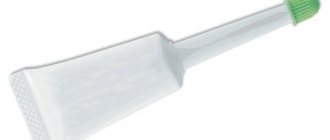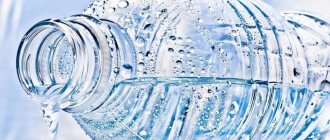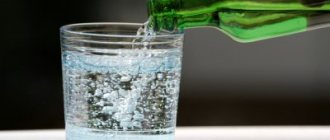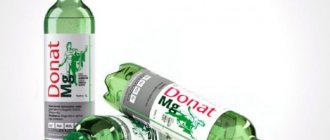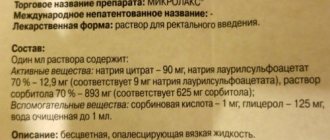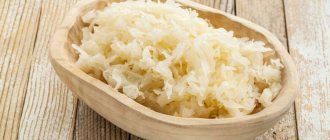Wellness with alkaline mineral waters is more relevant now than ever. In a healthy body, the acid-base balance (pH) is maintained within certain limits. But during diseases, including infectious ones, the balance is disrupted and shifts towards an acidic environment - acidosis develops. It is in an acidic environment that bacteria and viruses feel best and begin to multiply more actively.
To reduce the risk of infections, you can take alkaline mineral waters to restore normal blood pH. Also, during ARVI, drinking mineral waters helps to normalize the water-salt balance, since at elevated temperatures the body loses not only water, but also minerals.
Komsomolskaya Pravda selected the best alkaline mineral waters in 2022.
Will mineral water help with this disease in adults?
The drink has a positive effect if a person has problems with bowel movements .
This is due to the properties of water. After entering the body, the mineral water affects the mucous membranes of the stomach and intestines.
Thanks to the liquid, irritation of the nerve fibers inside the esophagus, stomach and intestines occurs . Due to this, the stimulation of the gastrointestinal tract to work increases.
Mineral water improves the contraction of intestinal walls. Due to this, feces are better and faster removed from the body.
Shulpekova Yu.O. Algorithm for the treatment of constipation of various origins // RMZh. - Volume 15. - No. 15. - 2007.
For some anorectal changes of an anatomical nature, it is advisable to carry out surgical treatment.Laxatives
prescribed when non-drug treatment measures are ineffective. Modern laxatives according to their mechanism of action can be divided into the following classes:
- dietary fiber (syn "bulk laxatives"),
- osmotic laxatives based on salts, disaccharides and alcohols, polyethylene glycol,
- stimulant laxatives,
- auxiliary agents: prokinetics, antispasmodics, bile acid preparations.
Some laxatives have a combined effect.
Bulk laxatives
contain natural (plantain, plum, apple, dried apricot, guar gum) or synthetic fibers (methylcellulose, polycarbophil). In addition to simply increasing the volume of feces, dietary fiber has a laxative effect due to the increased production of short-chain fatty acids in the intestines, as well as due to the content of plant glycosides in herbal preparations, which have a stimulating effect. In most cases, prescribing dietary fiber is the first step in treating constipation. Ideally, the content of plant fiber in the daily diet should be 25 g. When giving advice to the patient, it should, however, be emphasized that the fiber content in the daily diet should be increased gradually (over 1-2 weeks), constantly assessing the effectiveness and tolerability of this measure. For example, in patients with slow peristalsis or intestinal obstruction, high fiber content in food in some cases leads to the formation of fecal blockages. With an “inert colon”, for many patients, on the contrary, it is advisable to prescribe a diet with a reduced content of plant fibers.
The formation of fecal blockages during “treatment” with a diet rich in fiber can also be observed in anorectal disorders, when the difficulty of defecation worsens with an “unusual” increase in the volume of feces.
Therapeutic effect of osmotic laxatives
consists of attracting water into the intestinal lumen along an osmotic gradient. This is accompanied by an increase in the volume of contents and easier movement, the consistency of stool becomes softer, and the frequency of bowel movements increases. There are osmotic laxatives based on salts (magnesium - sulfate, phosphate, oxide, hydroxide, citrate and sodium - sulfate, bicarbonate), disaccharides (lactulose), alcohols (sorbitol, glycerol, mannitol) and polyethylene glycol. The undesirable side of the action of osmotic laxatives is that their action spreads throughout the intestines and carries the risk of electrolyte disturbances (this is especially true for saline laxatives and alcohols), while the point of application of the “ideal laxative” should be the colon. In patients with cardiovascular and renal insufficiency, saline osmotic laxatives may cause volume and electrolyte overload.
Osmotic laxatives based on lactulose and polyethylene glycol are considered second-line drugs for the treatment of constipation of any type. Typically, osmotic laxatives are recommended when non-drug methods and dietary fiber are ineffective. In addition, they are used to treat occasional constipation. The question of how long osmotically active drugs can be taken continuously remains poorly understood. The FDA has approved the use of lactulose and polyethylene glycol-3350 for short-term or occasional use. When taking lactulose, a dose-dependent side effect of bloating may occur. Emollients are surfactants that improve the penetration of water between solid stool particles. The FDA has approved docusate sodium and docusate calcium for the treatment of occasional constipation. However, data from small clinical trials showed no difference in the effectiveness of docusate and placebo and showed a higher effectiveness of psyllium preparations when compared with docusate.
Emollients also include petroleum jelly, glycerin, and vegetable oils (almond, olive). These agents also have a mild irritating effect, stimulating peristalsis.
“Therapeutic niche” of emollients: occasional use for coprostasis in older people, with limited mobility, prevention of constipation in patients who cannot strain during bowel movements (painful processes in the anorectal area, postpartum period). Side effects: local irritant, decreased defecation reflex with long-term use, fecal leakage, impaired absorption of fat-soluble vitamins.
Stimulant laxatives
have an effect on the chemoreceptors of the intestinal mucosa, due to which peristaltic activity is enhanced, and the reabsorption of water and electrolytes by the epithelium is additionally suppressed. Stimulant laxatives include bisacodyl, castor oil, and senna preparations. The duration of treatment with stimulant laxatives should not exceed 7-10 days, as they carry the potential for electrolyte disturbances. They are used both for episodic constipation and for worsening chronic constipation. Most often, these drugs are prescribed for the prevention of constipation in conditions where straining is prohibited or difficult (postpartum period, condition after perineal surgery, anal fissures, paraproctitis, debilitated patients), as well as for preparation for intestinal examinations.
It is possible to simultaneously prescribe laxatives from two groups: a stimulating and bulk laxative or a stimulating and osmotic laxative, with a gradual reduction in the dose and withdrawal of the stimulant.
A significant disadvantage of castor oil is that its irritant effect extends to the small intestine, which can lead to digestive problems, watery diarrhea and loss of electrolytes. Currently, castor oil can only be recommended for preparation for examinations - colonoscopy, irrigoscopy.
Senna preparations are still very popular among the population, mainly due to their plant origin. However, long-term use of senna carries a risk of damage to intestinal nerve cells, the development of pseudomelanosis intestines (considered a precancerous condition), as well as interstitial nephritis.
The most modern and safe of stimulant laxatives are bisacodyl and sodium picosulfate. These remedies can be taken for any type of constipation, both episodic and chronic.
When taken orally, bisacodyl and picosulfate undergo transformations under the action of enzymes of intestinal microflora, the final product is the active metabolite biphenol (Fig. 2).
The difference in the effect of mineral water in spastic and atonic difficult bowel movements
Spastic or spasmodic constipation in humans is expressed in increased muscle tone of the intestines . The result is severe tension inside the organ. All this manifests itself in the form of spasms. They are painful.
Mineral water relaxes overly tense intestinal muscles. The drink relieves pain and helps stop sharp spasms inside the organ. The result is the restoration of normal fecal movement.
Atonic is expressed in relaxation of the intestinal walls . As a result, due to the lack of muscle contractions, feces cannot move further to exit the body.
Mineral water improves the contraction of intestinal walls. Water irritates the nerve endings inside the organ. Thanks to it, it begins to contract better, removing stagnant feces from the body.
Which one is better to choose: selection rules and brands
For spasmodic and atonic constipation, different types of mineral water should be consumed. When choosing drinks, it is necessary to take into account their mineralization indicator . Their composition also plays a role.
With spasmodic
If you have this type of difficulty defecating, it is necessary to drink medicinal water of low mineralization or a drink with its average value. In such water, mineralization should not exceed 8 g per liter.
You should also choose a mineral water that contains:
Sodium to relieve inflammation in the intestines.- Magnesium to get rid of mucus inside the organ and eliminate inflammation.
- Bicarbonates for stool thinning.
- Chlorine to weaken the process of water absorption in the intestines.
- Sulfates also reduce the absorption of fluid into the intestinal walls.
Mineral water used for spasmodic constipation should not be carbonated.
For this type of difficult bowel movement, it is recommended to drink the following brands of mineral water:
- "Narzan".
- "Smirnovskaya".
- "Essentuki No. 4".
You can drink mineral water under the brands “Slavyanskaya” and “Uglichskaya”. “Moskovskaya” is also suitable.
With atonic
For this problem, it is recommended to drink water with a high mineralization rate. It must be at least 10 g per liter.
also drink a drink with a mineralization of 20 g per liter . It is not recommended to drink medicinal water with a mineralization of more than 20 g per liter if you have atony.
When choosing a mineral water, you should pay attention to its composition. This drink must contain magnesium and sodium. Its components should also include sulfates and chlorine.
If you have atony, you need to drink Borjomi. The mineralization of the drink is 10 g per liter. “Essentuki No. 17” is also suitable. In this mineral water, mineralization is 10-14 g/l.
Features of mineral waters
Medicinal table water should not be consumed constantly.
Not every water that has a mineral composition can be considered mineral water.
It must be obtained exclusively from an officially registered underground source.
The final product must meet all declared characteristics. Features of mineralization are the basis for dividing all waters into 3 types:
- Medicinal. They contain 10 – 15 g/l of minerals. You should not use them on your own; you need to get a doctor’s prescription and drink water under the constant supervision of specialists. Do not consume too much of them; due to excess, salt deposition may begin in the body.
- Medical canteens. Mineralization from 1 g/l to 10 g/l. However, people do not drink such water all the time. After all, their composition is quite active.
- Dining rooms. The amount of minerals in them is extremely low - no more than 1 g/l. Therefore, they cannot harm, you can drink them as much as you want. If you choose a composition that matches the needs of the body, with the help of such a drink you can gradually have a beneficial effect on the body.
Contraindications for use
Medicinal water should not be drunk if you have the following diseases and conditions of the body:
- vomit;
- pain in the intestines of unknown origin;
- internal bleeding;
- neoplasms in the intestines;
- bacterial and viral infections in the digestive organs;
- ulcers in the intestines;
- severe inflammatory processes in the kidneys;
- renal failure;
- hypertension.
Mineral water should not be consumed if a person is undergoing surgery to remove kidney stones.
Pharmaceutical products to ease bowel movements
Alternative treatment for constipation does not replace taking pharmaceuticals. In case of prolonged retention of stool, Fitomucil Norm will come to the rescue. Biocomplex:
- has a balanced composition - contains plum pulp and plantain seed shell,
- It is highly safe - made without artificial additives, suitable for children over 3 years old, pregnant and lactating women, and the elderly.
How to take Fitomucil Norm correctly for constipation, read the instructions. When taking the complex, it is important to maintain a drinking regime and consume water in sufficient quantities.
Bibliography
- https://minzdrav.gov.ru/documents/8129-rekomendatsii-po-povedeniyu-grazhdan-v-usloviyah-zharkoy-pogody
How to drink?
For spasmodic constipation, it is recommended to drink very warm mineral water. Its temperature should be about 45C.
It is necessary to drink medicinal water before meals. It is advisable to do this within 20 minutes. The mineral water is drunk in small sips .
For spastic constipation, mineral water is consumed three times a day. On the first day, drink half a glass. In the following days, the volume of water drunk at a time should increase. But this must be done gradually.
For spasmodic constipation, you need to drink about 70-100 ml of warm mineral water at a time.
For atony, the medicinal drink is drunk according to a slightly different scheme .
Mineral water is also consumed three times a day before meals. But this must be done a much longer period of time before eating. It is better to take the drink one and a half hours before meals. The temperature of the mineral water should be a maximum of 24C. The optimal value is 18-20C.
The liquid should be drunk quickly . It is recommended to take large sips. You need to drink about 80-100 ml at a time.
Rules for use for constipation
You can cleanse your body of waste and toxins using mineral water.
Stelmas with magnesium for constipation. The mineral water is rich in silicon and other components. Removes excess fluid, breaks down fat cells. Protects the liver and restores its functions. Regulates the level of cholesterol and salt deposits in the body. Reduces the risk of strokes and heart attacks. It has a diuretic effect and normalizes mineral metabolism. Increases colon peristalsis. Useful during pregnancy and breastfeeding (the components have a positive effect on the central nervous system and the skin of the fetus). Increases the secretion of bile and has a mild laxative effect. Helps lower blood sugar, helps the pancreas produce insulin in satisfactory quantities.
Read also: Every other day fasting: principles, effectiveness and features
Lysogorsk mineral water. Rich in magnesium, which extracts fluid from the intestinal walls. As a result, increased pressure on the intestinal walls, improved peristalsis and elimination of constipation. Not addictive. When taking a course (three times a day for a month, a glass of warm water 15-20 minutes before meals), you should limit the use of table salt.
Raisin water. Productive in the treatment of constipation in children and the elderly. Prepared at home: 200 ml of boiling water, pour 1 tbsp. l. raisins and leave for an hour. When using it, it is important to eat right, eat raw fruits, cereals, soups to promote easy functioning of the gastrointestinal tract.
Other
Dill liquid:
- For adults: 2 tbsp. l. Dill seeds are poured into 0.5 liters of boiled water and left for 30 minutes. Take in three doses of 90 ml 20 minutes before eating.
- For colic in babies: ½ tsp. dill seeds per 100 ml of hot water. Infuse, strain. Use fresh infusion every day. Give 1 tsp. before each feeding (up to 5 times a day).
Honey. Dissolve a spoonful of natural honey in a cup of warm water. Drink on an empty stomach. The drink has a relaxing effect and renews the activity of the stomach.
Lemon. The juice of half a lemon is diluted in a glass of warm liquid. Drink on an empty stomach. Elimination of stagnation in the colon occurs without the use of drugs. Drinking into the stomach stimulates the secretion of gastric juice. Not recommended for use with high acidity.
Salt water for constipation. Should be used for treatment with caution. When cleansing the walls of the stomach from toxins, the saline solution can harm people suffering from hypertension and kidney disease. You should follow a diet for a week before treatment. A glass of salty liquid (9 g of salt per 1 liter of water) is drunk on an empty stomach, two hours later, two more glasses are taken and a massage is done in the abdominal area. For one day, only boiled rice and rye bread are left in the diet.
Cucumber. Speeds up metabolism, copes with lack of water and eliminates constipation. ½ kg of fresh cucumbers, cut into rings, are poured with cool liquid and left for eight hours. Add a small amount of mint leaves to the infusion and squeeze out the juice of half a lemon. Drink throughout the day.
Read also: Rules for conducting and effectiveness of potato fasting day
What to combine with to improve the effect?
For constipation, in addition to mineral water, you should adhere to a diet. It should include laxative drinks.
Along with mineral water, you should drink natural compotes with dried apricots and prunes.
To improve intestinal contractions, it is also recommended to consume the following juices:
- freshly squeezed apple with pulp;
- tomato;
- carrot with pulp;
- potato-beetroot.
Along with mineral water, it is also recommended to consume fresh kefir. You can eat pumpkin puree. Green tea with milk has a good effect. Chamomile decoction has a laxative and anti-inflammatory effect.
To improve intestinal function, it is recommended to drink 5 ml of fresh aloe juice three times a day . During constipation, it is necessary to limit meat consumption. Preference should be given to plant-based foods.
Dried fruits have a good laxative effect. This is especially true for dried apricots. Have a beneficial effect on the intestines:
- carrot,
- beet,
- berries,
- figs,
- flaxseeds,
- nuts,
- cereals and porridges on water.
These products can be consumed along with mineral water.
With or without bubbles?
Mineral water can be carbonated or without gas. If for medical reasons you drink, for example, Essentuki 17, which can only be carbonated, you have no choice. If there are no such strict frameworks, decide for yourself - water “with bubbles” or without. First of all, the gas can be natural or artificially added. The second option seems dubious to gastroenterologists: “non-native” gas can interfere with the absorption of mineral substances in the water itself. In addition, there is an opinion that in general any carbonated liquid contributes to the appearance of cellulite. By the way, it happens that gas naturally disappears from natural carbonated water. And before bottling it is again, artificially, added to the water. Taking into account all of the above, I would like to stick to water without gas - sin gas or eau naturelle.
If you still choose “soda”, keep in mind: firstly, no more than 2 glasses a day (otherwise the main effect of use will be a bloated belly). Secondly, for chronic gastritis with high acidity and ulcers, mineral water is drunk quickly, almost in one gulp, and for normal and low acidity - slowly, in small sips.
